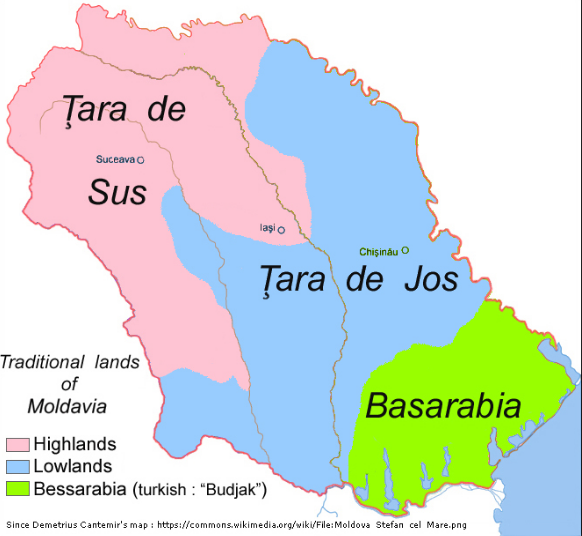*a Living dance is a 1st Generation dance that is still performed in the country of origin (or immigrant communities) as part of a social event like a wedding where others can participate (not for an audience) by people who learned the dance informally (from friends and relatives by observation and imitation, not in a classroom situation). For more information, click here and here.
Ţărăneasca, Ruseasca, Rusască, three words for essentially the same dance, is a classic example of a Living dance. Where it is popular (most of Moldavia) there are many ways to do it, and those many ways may be danced in the same space simultaneously. Ţărăneasca, from Ţărăn, “the man who tills the soil” means “peasant-like”, Ruseasca, Rusasca, both mean “Russian-like”. Which term is used seems to depend of whims of village taste more than geographical boundaries, though western Moldavia generally prefers Ţărăneasca, while the east (closer to Russia) tends to prefer Rusească/Rusască.
Anca Giurchescu, in Romanian Traditional Dance, (1995), states “In Moldavia, it is Ţărăneasca and polka-like dances that dominate village repertoires.” The terms Ţărăneasca, Ruseasca, Rusască, seem to refer to both the kind of fast 2/4 music, either instrumental or vocal, used to accompany the dances, and the dances themselves.
The dance was considered a fairly specific small-circle dance. According to the captions (by Fabr1s) on the YouTubes below, “Țărăneasca” (lit. translated “peasant-like”) is a Moldavian small circles dance where the dancers are linked by back basket hold and the circle revolves rapidly, generally in both directions. Its dancing style is pretty similar with the southern Transylvanian “Jiana” (sometimes called “Jieneasca” or “Râureanca”).” To my mind, it bears a striking similarity to the Croatian Drmeš, especially the last YouTube shown here, which is bi-directional.

Nowadays it appears from the YouTube evidence below that Ţărăneasca/Ruseasca/Rusască includes both small-circle, large-circle-Sârba (T-6) dances, and Invârtita-style (woman crossing back & forth in front of man) and Polka-style (tight circles as a couple in two-step rhythm) couple dances.
Of the Polka, Giurchescu says the dominance of the Polka-type “is due to an accelerated and distinct evolutionary pattern along with the strong influence of the semi-cultivated ballroom dances which flourished in the Eastern Moldavian zone zone prior to the turn of the [20th] century. The numerous variants of the Turning Polka type….are either local adaptations of the well known and widespread polka type or else indigenous creations based on the polka model. Local people consider these dances part of their traditional inheritance and call them by their generic name Polcuțe (little polkas).”
As explained here, from 1775 to 1918, this part of Moldavia was renamed Bucovina, and attached to the Austro-Hungarian Empire, original home of the Polka, (the first turning couple dance to sweep Europe; for details, click). While the rest of Romania was still under the spell of the Ottomans, this corner of Romania, bordering on what is now Slovakia and Poland, was under the influence of Vienna-based Western Europe. As the local nobility and developing middle-class tried to adjust to its new overlords, it was only natural they would learn new dances, which would filter down to the peasants, likely in modified form.
Giurchescu says of Northern Moldavia “Traditionally, each community organizes its dances into a fairly fixed suite according to a pattern: an introductory Hora mare, followed by a series of mixed or men’s group dances….succeeded by set couple dances of various types, and almost always closed by the rapid, small-group circling dance Ţărăneasca (Rusească).
Ţărăneasca
In the songs below, along with the Gârcina performing group demonstration, Strigaturi are inserted. Giurchescu lists these couplets as a few of many associated specifically with Ţărăneasca:
Haideți fetelor la joc Come on, girls, join the dance Da v-ar Dumnezeu noroc God bless you, good luck and health Si noroc și sănătate Good luck and health Să vă dăm la bărbățe We wish that we could all marry you, Să vă dăm pe la bărbați We wish that we could give you (find for you) a man. Ca să nu ne blestemați So that you'll never curse us.
Singer Andreea Haisan https://www.youtube.com/watch?v=58m82MFadyQ&t=6s

Below, dancers have the option of dancing in small circles or Invârtita and Polka-type couples.

Singer Ilie Caraş Dance – Sârba (T-6) https://www.youtube.com/watch?v=_YuOzJDVo8w
Singer Georgiana Onuti, Câmpulung Here the full range of dance options are shown – Small circle, Sârba (T-6), Invârtita-style couples, and Polka-style couples. https://www.youtube.com/watch?v=ODGTcSfnGi0&t=141s

Gârcina, Neamț region, Hora, Taraneasca (1:57-2:45), Hangul. Here the circle is large, uni-directional, and features stamps. https://www.youtube.com/watch?v=pffV6ZESJW0


Rusască

Zece Prăjini (“Ten Fields”), population 400, is the village from which the Roma brass band Fanfare Ciocărlia originate.
Rusească


Ardeleana, Polka & Sârba in Iași, 2015 https://www.youtube.com/watch?v=1JMm-F5HpBM

